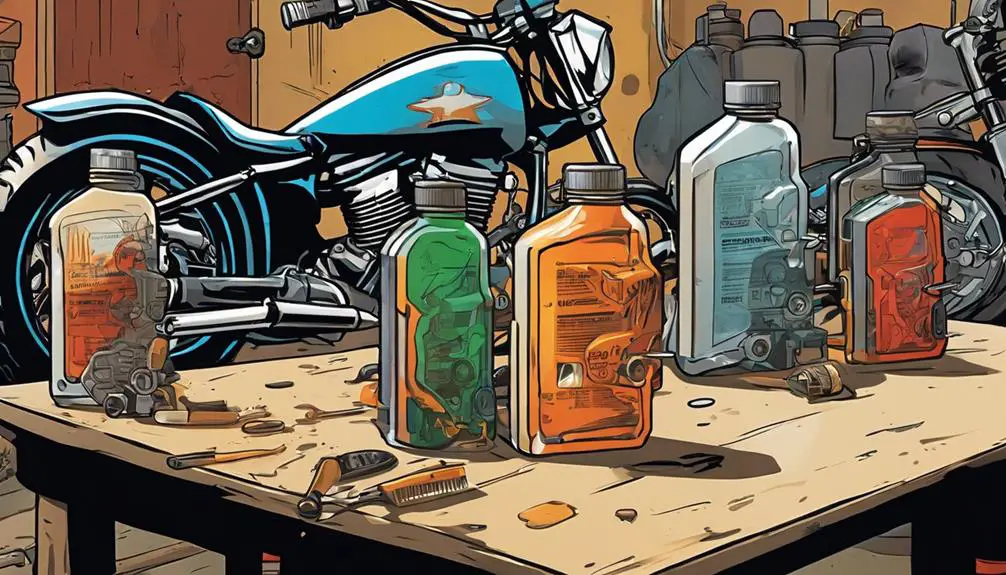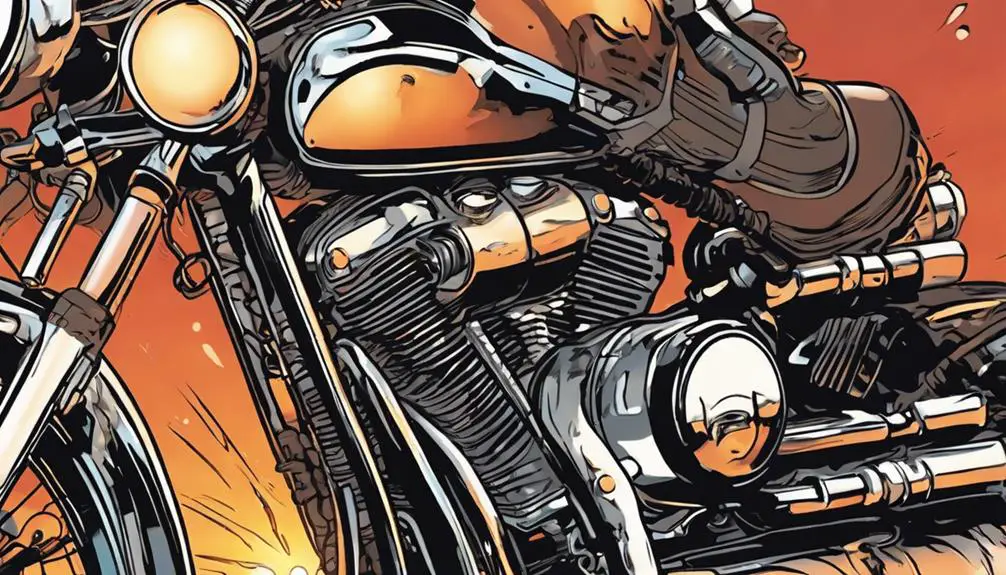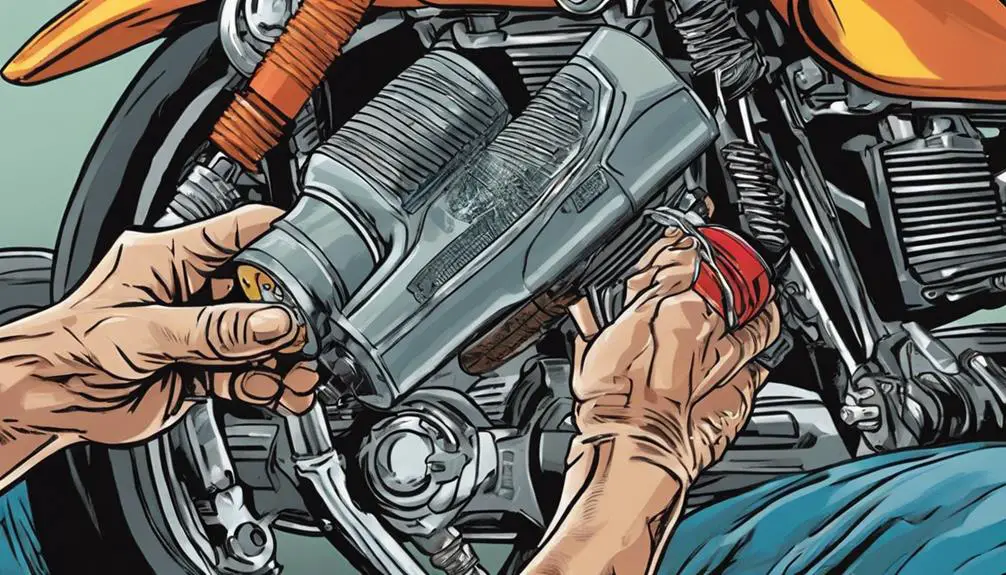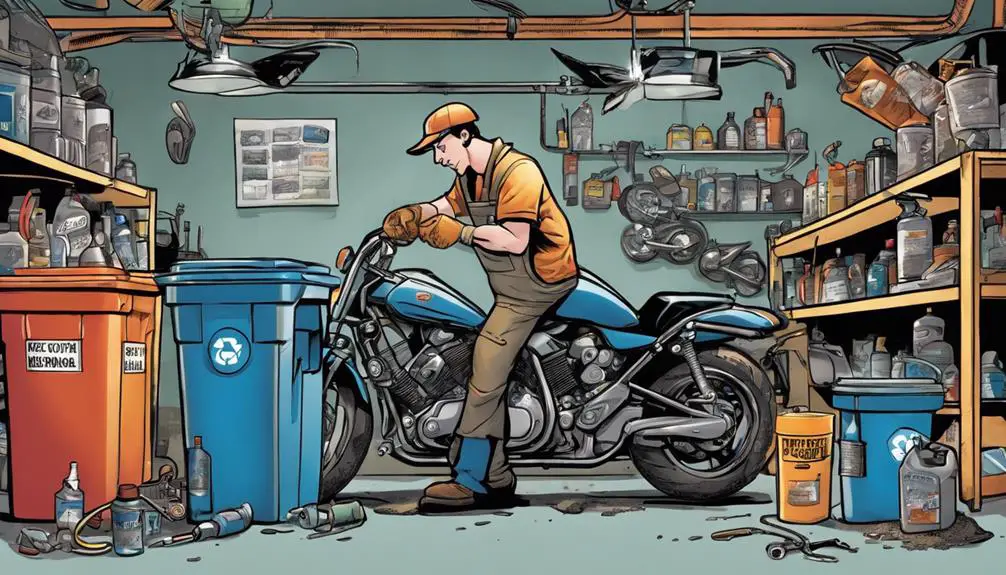When it's time for your motorcycle oil change, you might be surprised at how a few simple tips can make the process smoother and more effective. Start by consulting your owner's manual to guarantee you're using the right oil type and capacity. It's also important to warm up the engine beforehand, as this helps the old oil drain out more easily. But that's just the beginning; there are a few more essential steps you won't want to overlook. Let's explore how to make your oil change as efficient as possible.
Key Takeaways
- Warm up the engine for 5-10 minutes to reduce oil viscosity, making it easier to drain.
- Always use the recommended oil type and viscosity from the owner's manual for optimal performance.
- Inspect the oil drain plug for wear or damage before reinstalling to prevent leaks.
- Apply a thin layer of fresh oil to the new oil filter gasket to ensure a proper seal.
Choose the Right Oil

Choosing the right oil for your motorcycle is essential to guarantee peak performance and engine longevity. You've got the freedom of the open road ahead, and the right oil can help you fully embrace that experience.
Start by checking your owner's manual; it'll guide you on the recommended viscosity and type. Most riders prefer synthetic oil for its superior protection and performance, especially in extreme temperatures. It's a choice that allows your engine to run smoother and last longer.
Next, consider the additives in the oil. Detergents and anti-wear agents can greatly enhance your bike's performance, ensuring you get the most out of every ride. You want to liberate your engine from sludge and deposits, allowing it to breathe and perform at its best.
Gather Necessary Tools
Before diving into your oil change, make sure you've got all the necessary tools at hand to make the process smooth and efficient. Having the right equipment not only saves you time but also gives you the freedom to get your hands dirty without any hiccups.
Here's a quick list of essentials you'll need:
- Socket wrench set: This'll help you remove the drain plug with ease.
- Oil filter wrench: You'll want to make sure you can easily remove and replace your oil filter.
Don't forget to have some rags handy too, as they're great for wiping off any excess oil.
By gathering these tools beforehand, you'll set yourself up for a successful oil change. You're not just maintaining your bike; you're embracing the spirit of independence that comes with being a motorcyclist.
Warm Up the Engine

Once you've gathered your tools, it's time to warm up the engine to guarantee the oil flows smoothly during the change. Start your bike and let it idle for about 5 to 10 minutes. This step's essential—it heats the oil, reducing its viscosity and allowing it to drain more easily.
As you listen to the engine hum, feel that connection to your ride; it's a reminder of the freedom it brings. While it warms up, take a moment to visualize the open road ahead, the wind against your face, and the thrill of the ride.
Keep an eye on the temperature gauge; you want the engine warm, not overheating. If you can, rev the throttle gently a couple of times—this action circulates the oil, ensuring it's all ready for your upcoming change.
Once the engine's warmed up and you've soaked in that liberating vibe, you're set to proceed. You're not just changing oil; you're empowering your motorcycle, enhancing its performance, and ensuring many more adventures await.
Enjoy the ride, and get ready for the next step!
Drain Old Oil Properly
Draining the old oil properly is essential to maintaining your motorcycle's engine health and guaranteeing a smooth ride. Start by warming up your engine for a few minutes. This helps the oil flow out easier, making your job simpler. Once warmed, turn off the engine and let it cool for a moment before proceeding to drain the oil.
When you're ready, gather the necessary tools and materials. Here are a few things to keep in mind:
- Use a quality oil pan: A sturdy container will catch every drop, so you don't make a mess.
- Find the right drain plug: Consult your manual to locate the drain plug and guarantee you have the right tools to remove it.
Once you've drained the oil, be responsible and dispose of it properly. Many auto shops accept used oil, or check for local recycling centers.
Taking these steps will keep your motorcycle purring and ready for your next adventure.
Replace the Oil Filter

When it comes to replacing your oil filter, choosing the right one is essential for your bike's performance.
You'll also want to follow proper installation techniques to guarantee everything fits snugly and operates smoothly.
Let's break down these key points to help you through the process.
Choosing the Right Filter
Selecting the right oil filter is essential for ensuring your motorcycle runs smoothly and efficiently. The filter plays a vital role in removing contaminants from the engine oil, protecting your bike's engine, and enhancing its performance. When you're ready to choose a new filter, keep a few key points in mind.
Compatibility: Make sure the filter fits your motorcycle's make and model. Check the owner's manual or consult a knowledgeable source.
Quality: Don't skimp on quality. Investing in a reputable brand can save you from future headaches and costly repairs.
Maintenance Schedule: Consider how often you ride and your maintenance routine. If you ride frequently, a higher-quality filter can provide better filtration and longer life.
Proper Installation Techniques
Once you've chosen the right oil filter, it's time to focus on the proper installation techniques to confirm it functions effectively.
Start by making sure the engine is cool, so you can work without the risk of burns. Remove the old filter carefully, using an oil filter wrench if necessary. Be mindful of the old gasket; it should come off with the filter. If it doesn't, remove it to prevent leaks.
Before installing the new filter, apply a thin layer of fresh oil to the rubber gasket. This helps create a seal and makes removal easier during your next oil change. Screw the new filter on by hand until it's snug, then tighten it an additional three-quarters of a turn. Avoid over-tightening, as this can damage the filter.
Once the new filter is in place, double-check your work. Wipe up any spills and make sure everything is clean. Finally, fill your engine with fresh oil, and you're ready to ride free and confident, knowing you've taken an essential step in maintaining your machine.
Your motorcycle deserves the best, and so do you!
Add New Oil Carefully
Carefully pour the new oil into the engine, ensuring you don't overfill it. Taking your time here is essential, as too much oil can lead to unwanted pressure and potential damage. Use a funnel if necessary to keep everything neat and avoid spills. Remember to check your owner's manual for the correct oil capacity for your motorcycle model.
As you pour, keep these tips in mind:
- Use the Right Oil: Make sure you're using the oil type recommended for your bike. Different engines have different needs.
- Check the Level: After pouring, wait a moment and then check the oil level using the dipstick. You want it right at the recommended mark.
Adding new oil isn't just a chore; it's an important part of keeping your ride smooth and powerful. Embrace this moment, knowing you're taking control of your motorcycle's health.
Feel the freedom that comes with maintaining your machine and hitting the open road with confidence!
Dispose of Old Oil Responsibly

Responsible disposal of old oil is essential for protecting the environment and ensuring your motorcycle maintenance is eco-friendly.
When you change your oil, it's not just about the ride; it's about how you care for the planet, too. Never dump used oil down the drain or on the ground. It's harmful to wildlife and can contaminate water sources.
Instead, look for local recycling centers or auto shops that accept used oil. Many places provide this service for free or charge a small fee. Check your city's waste management guidelines; they often have resources to help you find proper disposal methods.
You can also store the oil in a sealed container, like a jug or bottle, until you're ready to recycle it. Make sure to label it clearly to avoid any mix-ups.
Frequently Asked Questions
How Often Should I Change My Motorcycle Oil?
You should change your motorcycle oil every 3,000 to 5,000 miles, but it really depends on your riding habits and the type of oil you use.
If you ride hard or in extreme conditions, you might need to do it more often.
Keep an eye on your oil's color and consistency, too.
Staying on top of your oil changes will keep your bike running smoothly and give you the freedom to ride without worries.
Can I Mix Different Oil Brands?
You might think mixing oil brands is risky, but it can be done if you choose wisely.
Different brands often use similar base oils and additives, so blending them usually won't harm your engine. Just verify they meet the same specifications and viscosity.
However, for peak performance, it's best to stick with one brand. This way, you'll keep your ride running smoothly, and you won't have to worry about any potential issues.
What Happens if I Overfill the Oil?
If you overfill your motorcycle's oil, it can lead to some serious issues.
The excess oil can foam up, reducing lubrication and causing engine damage. You'll notice performance issues, like poor acceleration or strange noises.
Plus, the pressure might cause seals to leak, leading to messy spills.
It's essential to check your oil level regularly and keep it within the recommended range to guarantee your ride stays smooth and reliable.
Is Synthetic Oil Better Than Conventional Oil?
They say, 'You get what you pay for,' and that rings true with oil types.
Synthetic oil often offers better performance and protection compared to conventional oil. It resists breakdown, enhances engine efficiency, and can improve fuel economy.
While it might cost more upfront, the benefits can save you money in repairs down the line.
Do I Need to Change Oil During Winter Storage?
Yes, you should change your oil during winter storage.
Old oil can contain contaminants that may harm your engine while it sits idle.
By changing it, you create a protective barrier against corrosion and guarantee that fresh oil is ready for spring rides.
It's a simple step that keeps your motorcycle in top shape, so you can embrace your freedom on the road when the weather warms up!
Conclusion
Changing your motorcycle oil isn't just routine; it's essential for your bike's longevity.
Did you know that regular oil changes can extend an engine's life by up to 50%?
By following these tips, you not only keep your bike running smoothly but also enhance its performance and reliability.
So, take the time to perform this maintenance task correctly, and you'll enjoy many more miles on the road.
Happy riding!